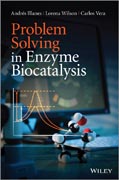
Problem Solving in Enzyme Biocatalysis
Illanes, Andres
Wilson, Lorena
Vera Alvarez, Carlos
Enzyme biocatalysis is a fast–growing area in process biotechnology that has expanded from the traditional fields of foods, detergents, and leather applications to more sophisticated uses in the pharmaceutical and fine–chemicals sectors and environmental management. Conventional applications of industrial enzymes are expected to grow, with major opportunities in the detergent and animal feed sectors, and new uses in biofuel production and human and animal therapy. In order to design more efficient enzyme reactors and evaluate performance properly, sound mathematical expressions must be developed which consider enzyme kinetics, material balances, and eventual mass transfer limitations. With a focus on problem solving, each chapter provides abridged coverage of the subject, followed by a number of solved problems illustrating resolution procedures and the main concepts underlying them, plus supplementary questions and answers. Based on more than 50 years of teaching experience, Problem Solving in Enzyme Biocatalysis is a unique reference for students of chemical and biochemical engineering, as well as biochemists and chemists dealing with bioprocesses. Contains: Enzyme properties and applications; enzyme kinetics; enzyme reactor design and operation 146 worked problems and solutions in enzyme biocatalysis. ................................................................................................................................................................................. Errata: Unfortunately due to an error, Dr Raúl Conejeros, School of Biochemical Engineering, Universidad Católica de Valparaíso, Chile has not been correctly credited for his contribution to this book. Dr Raúl Conejeros’ full name and affiliation should appear on the title page for Chapter 7. INDICE: Preface ix Nomenclature xi Epsilon Software Information xxi 1 Facts and Figures in Enzyme Biocatalysis 1 1.1 Introduction 1 1.1.1 Enzyme Properties 1 1.1.2 Enzyme Applications 2 1.2 Enzymes as Process Catalysts 3 1.3 Evolution of Enzyme Biocatalysis: From Hydrolysis to Synthesis 5 1.4 The Enzyme Market: Figures and Outlook 6 References 7 2 Enzyme Kinetics in a Homogeneous System 11 2.1 Introduction 11 2.1.1 Concept and Determination of Enzyme Activity 11 2.1.2 Definition of a Unit of Activity 13 2.1.3 Measurement of Enzyme Activity 13 2.2 Theory of Enzyme Kinetics 14 2.3 Single–Substrate Reactions 17 2.3.1 Kinetics of Enzyme Inhibition 18 2.4 Multiple–Substrate Reactions 19 2.4.1 Reaction Mechanisms 19 2.4.2 Kinetics of Enzyme Reactions with Two Substrates 20 2.5 Multiple–Enzyme Reactions 21 2.6 Determination of Kinetic Parameters 22 2.7 Effects of Operational Variables on Enzyme Kinetics 24 2.7.1 Effects of pH 25 2.7.2 Effects of Temperature 26 Solved Problems 29 Supplementary Problems 72 References 84 3 Enzyme Kinetics in a Heterogeneous System 87 3.1 Introduction 87 3.2 Immobilization of Enzymes 87 3.2.1 Immobilization on Solid Supports (Carrier–Bound Systems) 88 3.2.2 Immobilization by Containment 89 3.2.3 Immobilization in Carrier–Free Systems 89 3.2.4 Parameters of Enzyme Immobilization 90 3.2.5 Optimization of Enzyme Immobilization 91 3.3 Mass–Transfer Limitations in Enzyme Catalysis 92 3.3.1 Partition Effects 93 3.3.2 External Diffusional Restrictions in Impervious Biocatalysts 94 3.3.3 Internal Diffusional Restrictions in Porous Biocatalysts 97 3.4 Determination of Intrinsic Kinetic and Mass–Transfer Parameters 102 3.4.1 EDR 102 3.4.2 IDR 104 Solved Problems 105 Supplementary Problems 127 References 138 4 Enzyme Reactor Design and Operation under Ideal Conditions 141 4.1 Modes of Operation and Reactor Configurations 141 4.2 Definition of Ideal Conditions 142 4.3 Strategy for Reactor Design and Performance Evaluation 143 4.4 Mathematical Models for Enzyme Kinetics, Modes of Operation, and Reactor Configurations under Ideal Conditions 143 4.4.1 Batch Enzyme Reactor 144 4.4.2 Continuous Enzyme Reactors 148 Solved Problems 157 Supplementary Problems 174 References 179 5 Enzyme Reactor Design and Operation under Mass–Transfer Limitations 181 5.1 Sequential Batch and Continuously Operated Reactors with Immobilized Enzymes 182 5.2 Mathematical Models for Enzyme Kinetics, Modes of Operation, and Reactor Configurations under Mass–Transfer Limitations 183 Solved Problems 185 Supplementary Problems 198 6 Enzyme Reactor Design and Operation under Biocatalyst Inactivation 203 6.1 Mechanistically Based Mathematical Models of Enzyme Inactivation 203 6.2 Effect of Catalytic Modulators on Enzyme Inactivation 205 6.3 Mathematical Models for Different Enzyme Kinetics, Modes of Operation, and Reactor Configurations under Biocatalyst Inactivation 206 6.3.1 Nonmodulated Enzyme Inactivation 206 6.3.2 Modulated Enzyme Inactivation 209 6.4 Mathematical Models for Enzyme Kinetics, Modes of Operation, and Reactor Configurations under Simultaneous Mass–Transfer Limitations and Enzyme Inactivation 212 6.5 Strategies for Reactor Operation under Biocatalyst Inactivation 213 Solved Problems 215 Supplementary Problems 233 References 240 7 Optimization of Enzyme Reactor Operation 243 7.1 Strategy for the Optimization of Enzyme Reactor Performance 244 7.1.1 Objective Function 244 7.1.2 Variables for Optimization of Enzyme Reactor Performance 246 7.1.3 Determination of Optimum Temperature 247 7.2 Mathematical Programming for Static Optimization 247 7.3 Dynamic Programming 248 7.4 Statistical Optimization by Surface Response Methodology 249 7.4.1 Assessing the Quality of SRM and its Parameters 251 7.4.2 Process Optimization by SRM 252 Solved Problems 254 Supplementary Problems 272 References 275 Appendix A Mathematical Methods 277 A.1. Newton’s Method 277 A.2. Curve Fitting by Least Squares 280 A.2.1 Linear Regression 280 A.2.2 Nonlinear Regression 286 A.3. Solving Ordinary Differential Equations 296 A.3.1 Solving First–Order Ordinary Differential Equations by the Separation of Variables 296 A.3.2 Solving First–Order Ordinary Differential Equations Using an Integration Factor 297 A.3.3 Solving Second– and Higher–Order Linear Homogeneous Differential Equations with Constant Coefficients Using their Characteristic Equations 298 A.3.4 Solving Second– and Higher–Order Linear Homogeneous Differential Equations with Variable Coefficients 301 A.4. Numerical Methods for Solving Differential Equations 302 A.4.1 The Euler Method 302 A.4.2 The Fourth–Order Runge–Kutta Method 303 A.4.3 The Finite–Difference Method 303 References 310 Index 311
- ISBN: 978-1-118-34171-1
- Editorial: Wiley–Blackwell
- Encuadernacion: Cartoné
- Páginas: 344
- Fecha Publicación: 29/11/2013
- Nº Volúmenes: 1
- Idioma: Inglés
